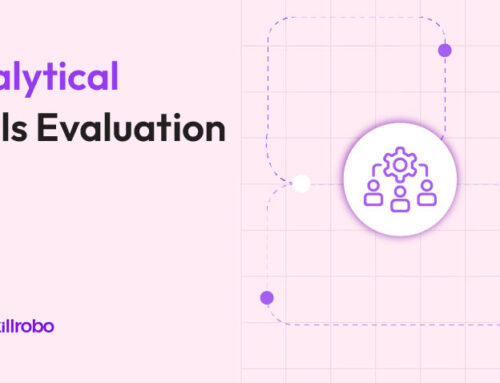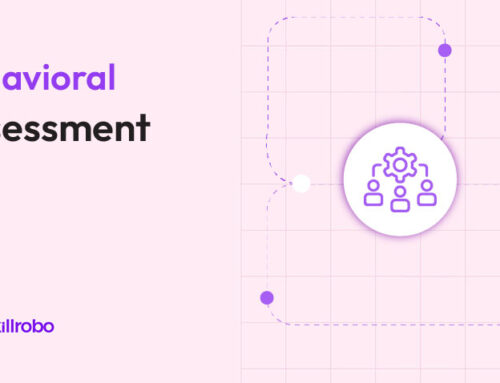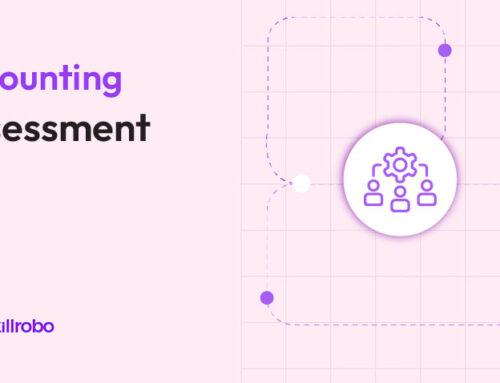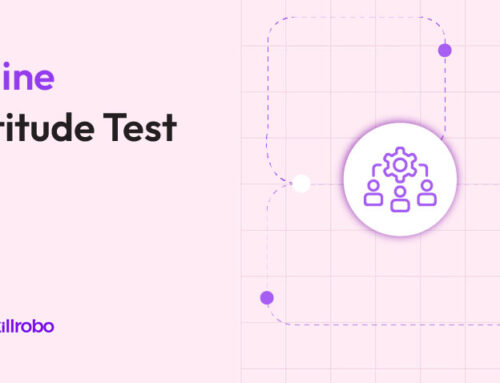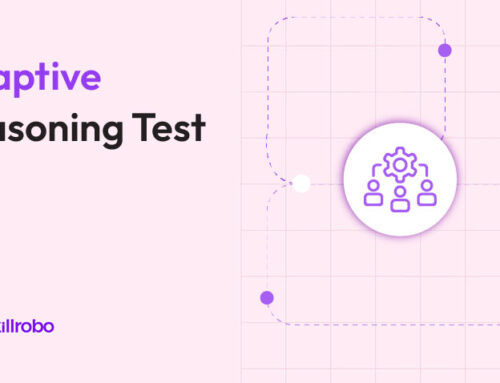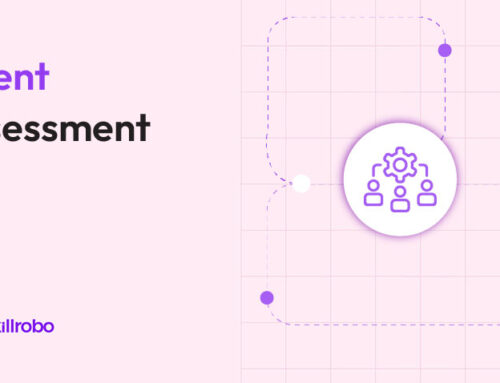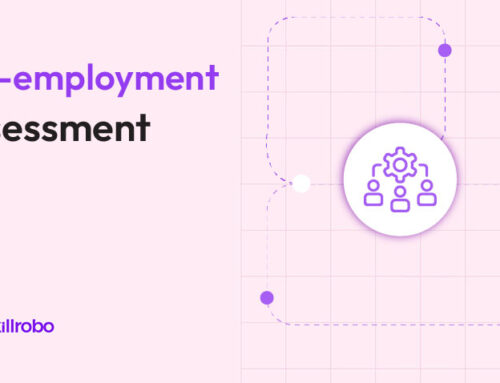Table of Contents
- Key Takeaways
- Why Assessing Communication Skills Matters in Hiring
- What Makes Communication Skills So Important?
- Key Components of Communication Skills in Aptitude Tests
- Types of Test Formats Used
- Pro Tips for Designing Effective Communication Tests
- Analyzing Test Results for Better Hiring Decisions
- Challenges in Communication Skills Testing
- Skillrobo: Streamlining Communication Skills Assessment
- Conclusion: The Smarter Way to Screen Communication
Related articles
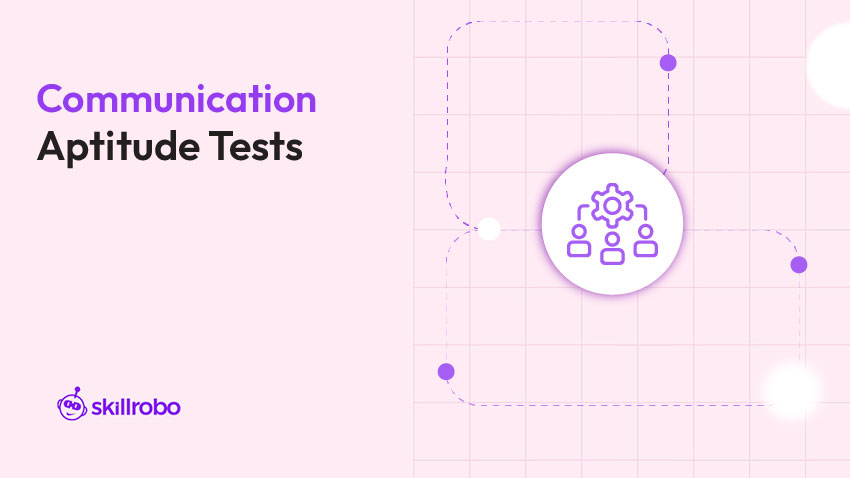
Key Takeaways
- Online aptitude tests assess verbal, written, and non-verbal communication using various question types to measure clarity, fluency, and comprehension skills.
- Simulations and descriptive tasks provide insights into a candidate's practical communication style, tone, response structure, and situational judgment accuracy.
- Grammar, vocabulary, and comprehension-based multiple-choice questions reveal a candidate's ability to write persuasively.
- Detailed test reports offer recruiters categorized insights into candidate communication abilities, enabling faster, data-driven, and confident hiring decisions.
Why Assessing Communication Skills Matters in Hiring
Strong communication skills are essential across all roles—from client interaction to internal collaboration. However, interviews alone often fail to capture a candidate's full communication ability. Online aptitude tests offer a reliable way to assess verbal clarity, written expression, and listening comprehension. Tools like Skillrobo enable recruiters to test communication skills before hiring through role-based questions, grammar tasks, and descriptive writing exercises. These assessments provide structured, unbiased insights into how effectively candidates can convey and interpret information. In this blog, we'll explore how to assess communication skills using online aptitude tests and measure communication proficiency with accuracy and efficiency.
What Makes Communication Skills So Important?
Communication isn't just about speaking well—it involves listening, interpreting, and responding appropriately in a variety of scenarios. Strong communication enhances collaboration, reduces misunderstandings, and contributes to higher employee satisfaction.
Candidates who express ideas clearly, understand instructions promptly, and adapt their language depending on the audience often perform better across industries. As businesses shift toward hybrid and remote models, these skills are even more vital to team cohesion and performance.
Key Components of Communication Skills in Aptitude Tests
Online aptitude tests designed to evaluate communication skills typically focus on multiple aspects, each targeting different abilities that influence workplace communication. A well-structured test goes beyond grammar, encompassing verbal, written, auditory, and even perceptual skills.
1. Verbal Reasoning
This evaluates a candidate's ability to interpret spoken language, identify tone, detect intent, and make inferences from conversations. Questions may include listening to audio clips or reading transcripts, then answering questions that assess comprehension and contextual understanding. It's especially relevant for customer service and sales roles, where verbal clarity is critical.
2. Written Communication
Candidates are asked to write emails, summaries, or responses, enabling recruiters to assess grammar, sentence structure, coherence, and tone. This component reflects how effectively someone can articulate ideas in written form, which is essential for documentation, reporting, and digital communication. Platforms like Skillrobo offer features to design a pre-employment skill assessment test that includes job-specific writing tasks.
3. Active Listening
Some online tests incorporate audio questions where candidates listen to a short passage or conversation and then answer comprehension questions or summarize the key points. This evaluates how well the candidate can retain spoken information, process it quickly, and respond accurately—an essential skill in fast-paced work environments.
4. Non-verbal Understanding
Though harder to test online, this element can be evaluated through tone analysis, emotionally charged scenarios, or visual cues within video-based questions. It assesses how well a candidate can "read between the lines" and interpret unspoken cues—vital in roles that require empathy or conflict resolution.
5. Message Structuring
This newer element measures a candidate's ability to organize information logically. For instance, given a jumbled email draft, candidates may be asked to restructure it. It reflects thought organization, prioritization of information, and clarity, important in leadership and communication-heavy roles.
By combining these components, communication assessments give recruiters a comprehensive view of how candidates express, interpret, and structure information in workplace settings.
Types of Test Formats Used
Various online test formats are used to simulate real-world communication demands. Choosing the right format based on role complexity and communication requirements ensures more accurate screening.
1. Multiple-Choice Grammar and Vocabulary
These tests evaluate grammar knowledge, vocabulary range, sentence structure, and word usage. Candidates choose correct or best-fit answers based on context. This format works well for assessing baseline language fluency, especially in entry-level roles. It also supports auto-scoring and reduces evaluation bias.
2. Descriptive Writing Tasks
Candidates may be asked to write an internal email, summarize a product brief, or respond to a customer complaint. These exercises help recruiters assess tone, clarity, and information flow. Employers use this format to evaluate whether the candidate's writing aligns with the company's communication standards. For deeper insights, consider tests that assess soft skills in the pre-employment stage, including communication, empathy, and problem-solving.
3. Role-Based Simulations
Simulations mimic real-life work scenarios, asking candidates to handle a difficult client call or resolve a team dispute. These are especially useful for leadership roles, customer support, and cross-functional teams. The tasks help evaluate not just what a candidate says, but how they frame their response under pressure.
4. Audio and Video Response Questions
These formats record verbal responses to prompts, evaluating fluency, tone modulation, articulation, and coherence. This is particularly effective for assessing spontaneous communication—useful for sales roles, executive positions, and public-facing jobs.
5. Interactive Chat-Based Scenarios
Some platforms now include AI-based chat simulations where candidates respond to virtual customers in real-time. This assesses how quickly and appropriately they can type responses, mirroring live chat roles in customer service and tech support.
6. Listening-to-Action Mapping
In this format, candidates listen to a short instruction and then perform a task or answer a question based on it. It simulates situations where quick comprehension is necessary, such as taking instructions during meetings or client calls.
By using the right mix of these test types, organizations can better understand not just what a candidate knows, but how they apply communication skills in realistic workplace scenarios.
Pro Tips for Designing Effective Communication Tests
Creating effective communication assessments isn't just about choosing question formats—it's about structuring the test to reflect real job expectations. A well-designed test should evaluate the full spectrum of communication, from grammar to persuasive messaging.
1. Balance Objective and Subjective Formats
A mix of multiple-choice questions and open-ended responses ensures you assess both language mechanics and communication style. Objective questions are useful for quick scoring, while subjective tasks evaluate depth and creativity. Use a platform that allows you to build a pre-employment skill assessment checklist to structure this balance effectively.
2. Add Contextual Relevance
Customize tasks to align with the candidate's job role. For instance, a marketing role might include copywriting exercises, while a support role could simulate responding to a customer issue. Job-relevant tasks improve test validity and create a more meaningful assessment experience.
3. Set Time Limits Smartly
Set realistic time constraints that reflect typical workplace pressure but leave enough room for thoughtful responses. Timing is crucial—too short may trigger rushed answers, while too long might not simulate actual work scenarios.
4. Clarify Instructions
Even strong communicators can stumble on unclear prompts. Descriptive questions should include clear expectations, word limits, and evaluation criteria. To minimize ambiguity, tools like Skillrobo help automate pre-employment skill assessments with consistent formats and guidance.
5. Ensure Language Neutrality
Avoid jargon, regional idioms, or culturally specific references. Tests must be fair to candidates from diverse backgrounds. This is especially important in global hiring setups using cloud-based assessment platforms.
Analyzing Test Results for Better Hiring Decisions
Collecting test data is only valuable if it leads to informed hiring decisions. Communication assessments should go beyond numeric scores to offer deep behavioral and performance insights. This allows recruiters to predict not just capability, but also potential job performance.
1. Category-Based Skill Breakdown
Instead of a single aggregate score, quality assessments break results down into communication domains, such as vocabulary, tone accuracy, active listening, and grammar usage. This granularity helps recruiters determine which areas align with job needs. For example, a candidate with excellent writing but weak verbal reasoning may be better suited to content-heavy roles rather than client-facing positions.
2. Behavioral Markers in Performance
Modern platforms analyze behavioral trends such as speed of response, level of formality, or tone variations in writing and speaking tasks. These subtle markers often signal personality traits like confidence, adaptability, or critical thinking under pressure. Tracking filler word usage, sentence starters, and tone shifts can provide deeper insight into real-world communication habits.
3. Percentile and Peer Benchmarking
Recruiters benefit from percentile scores that compare candidates against a broader talent pool or previous high performers. Peer benchmarking reveals how close a candidate's communication skills are to the organization's top communicators, helping to align hires with internal standards.
4. Cross-Metric Visualization Tools
Visual dashboards help synthesize test results across candidates and job roles. By layering test data with performance trends, recruiters can identify high-potential candidates faster. This is especially powerful when used with data-driven insights from screening tools to refine job-fit predictions.
5. Integration with ATS and Onboarding
Linking test results with applicant tracking systems (ATS) or onboarding workflows allows a seamless transition from hiring to training. Recruiters can personalize early training modules based on individual communication gaps identified during testing, making the process holistic and efficient.
Challenges in Communication Skills Testing
Despite their benefits, online communication assessments come with inherent challenges that recruiters must address to ensure fairness, accuracy, and inclusivity. Recognizing these obstacles allows organizations to refine test formats and evaluation methods.
1. Subjectivity in Descriptive Evaluations
Open-ended responses often require human review, which can introduce inconsistency or bias. Without a well-defined rubric, evaluators may rate the same answer differently. Standardizing evaluation criteria—or using platforms that support peer-based employee assessments—can help normalize scoring and introduce multiple perspectives.
2. Cultural Sensitivity and Linguistic Barriers
Global teams face unique challenges in language fluency, idiomatic understanding, and communication norms. What sounds direct in one culture may seem impolite in another. Assessments should avoid regional idioms, ambiguous phrasing, or culturally loaded scenarios to maintain fairness. Localized versions or translated options can improve inclusivity.
3. Lack of Non-Verbal Communication Indicators
Non-verbal cues like body language, facial expressions, or hand gestures are critical in real-time communication. Online tests may overlook these aspects unless video-based or live assessments are included. For roles where non-verbal expression matters, such as negotiations or presentations, live simulation assessments can complement the test.
4. Technology, Comfort, and Accessibility
Not all candidates are equally familiar with digital testing environments. Poor internet access, device limitations, or discomfort with the interface can affect performance. Ensuring compatibility with mobile devices, providing mock tests, and offering simple user experiences can reduce this gap.
5. Over-Fitting to Test Environments
Some candidates may rehearse test-specific formats without truly possessing strong communication skills. This creates a false sense of competence. Designing tests with dynamic, unpredictable elements can make it harder to "game" the system and more accurately reflect genuine ability.
6. Mitigation Strategies
To overcome these limitations, organizations should combine multiple formats (MCQs, writing tasks, audio responses), implement calibrated scoring methods, and gather continuous feedback to improve test quality. Choosing flexible, scalable platforms with customization options ensures that communication tests evolve with hiring goals.
Skillrobo: Streamlining Communication Skills Assessment
Skillrobo is an online pre-employment assessment software built to simplify and optimize the hiring process. It enables organizations to evaluate candidates through tailored assessments that align with specific job requirements, including critical soft skills like communication.
Whether hiring for customer-facing roles, managerial positions, or team-based environments, Skillrobo allows recruiters to create customized tests that measure verbal, written, and listening skills effectively. Its flexible test creation tools ensure that each assessment reflects the communication standards expected in real-world work scenarios.
Key Features:
- Customizable Tests: Build tailored assessments or choose from a ready-to-use test library.
- AI-Powered Question Generator: SEYARC AI creates test questions even for niche communication needs.
- Cheating Prevention: Features such as webcam monitoring and tab tracking safeguard test integrity.
- Instant Reports: Recruiters receive categorized performance data for faster shortlisting.
- Public URL Access: Share test links directly with candidates or embed them on career pages.
- User Management: Admin-level control ensures secure and scalable test access.
Conclusion: The Smarter Way to Screen Communication
Evaluating communication skills isn't just about testing grammar—it's about measuring how well a candidate can express, persuade, and connect. Online aptitude tests bring structure, efficiency, and fairness to this process. With the right mix of formats, a focused scoring system, and practical simulations, organizations can ensure they're hiring individuals who can communicate with clarity, confidence, and impact.
Sign up for Skillrobo today to streamline your communication skills assessments and simplify your hiring decisions.

Key Takeaways
- Online aptitude tests assess verbal, written, and non-verbal communication using various question types to measure clarity, fluency, and comprehension skills.
- Simulations and descriptive tasks provide insights into a candidate's practical communication style, tone, response structure, and situational judgment accuracy.
- Grammar, vocabulary, and comprehension-based multiple-choice questions reveal a candidate's ability to write persuasively.
- Detailed test reports offer recruiters categorized insights into candidate communication abilities, enabling faster, data-driven, and confident hiring decisions.
Why Assessing Communication Skills Matters in Hiring
Strong communication skills are essential across all roles—from client interaction to internal collaboration. However, interviews alone often fail to capture a candidate's full communication ability. Online aptitude tests offer a reliable way to assess verbal clarity, written expression, and listening comprehension. Tools like Skillrobo enable recruiters to test communication skills before hiring through role-based questions, grammar tasks, and descriptive writing exercises. These assessments provide structured, unbiased insights into how effectively candidates can convey and interpret information. In this blog, we'll explore how to assess communication skills using online aptitude tests and measure communication proficiency with accuracy and efficiency.
What Makes Communication Skills So Important?
Communication isn't just about speaking well—it involves listening, interpreting, and responding appropriately in a variety of scenarios. Strong communication enhances collaboration, reduces misunderstandings, and contributes to higher employee satisfaction.
Candidates who express ideas clearly, understand instructions promptly, and adapt their language depending on the audience often perform better across industries. As businesses shift toward hybrid and remote models, these skills are even more vital to team cohesion and performance.
Key Components of Communication Skills in Aptitude Tests
Online aptitude tests designed to evaluate communication skills typically focus on multiple aspects, each targeting different abilities that influence workplace communication. A well-structured test goes beyond grammar, encompassing verbal, written, auditory, and even perceptual skills.
1. Verbal Reasoning
This evaluates a candidate's ability to interpret spoken language, identify tone, detect intent, and make inferences from conversations. Questions may include listening to audio clips or reading transcripts, then answering questions that assess comprehension and contextual understanding. It's especially relevant for customer service and sales roles, where verbal clarity is critical.
2. Written Communication
Candidates are asked to write emails, summaries, or responses, enabling recruiters to assess grammar, sentence structure, coherence, and tone. This component reflects how effectively someone can articulate ideas in written form, which is essential for documentation, reporting, and digital communication. Platforms like Skillrobo offer features to design a pre-employment skill assessment test that includes job-specific writing tasks.
3. Active Listening
Some online tests incorporate audio questions where candidates listen to a short passage or conversation and then answer comprehension questions or summarize the key points. This evaluates how well the candidate can retain spoken information, process it quickly, and respond accurately—an essential skill in fast-paced work environments.
4. Non-verbal Understanding
Though harder to test online, this element can be evaluated through tone analysis, emotionally charged scenarios, or visual cues within video-based questions. It assesses how well a candidate can "read between the lines" and interpret unspoken cues—vital in roles that require empathy or conflict resolution.
5. Message Structuring
This newer element measures a candidate's ability to organize information logically. For instance, given a jumbled email draft, candidates may be asked to restructure it. It reflects thought organization, prioritization of information, and clarity, important in leadership and communication-heavy roles.
By combining these components, communication assessments give recruiters a comprehensive view of how candidates express, interpret, and structure information in workplace settings.
Types of Test Formats Used
Various online test formats are used to simulate real-world communication demands. Choosing the right format based on role complexity and communication requirements ensures more accurate screening.
1. Multiple-Choice Grammar and Vocabulary
These tests evaluate grammar knowledge, vocabulary range, sentence structure, and word usage. Candidates choose correct or best-fit answers based on context. This format works well for assessing baseline language fluency, especially in entry-level roles. It also supports auto-scoring and reduces evaluation bias.
2. Descriptive Writing Tasks
Candidates may be asked to write an internal email, summarize a product brief, or respond to a customer complaint. These exercises help recruiters assess tone, clarity, and information flow. Employers use this format to evaluate whether the candidate's writing aligns with the company's communication standards. For deeper insights, consider tests that assess soft skills in the pre-employment stage, including communication, empathy, and problem-solving.
3. Role-Based Simulations
Simulations mimic real-life work scenarios, asking candidates to handle a difficult client call or resolve a team dispute. These are especially useful for leadership roles, customer support, and cross-functional teams. The tasks help evaluate not just what a candidate says, but how they frame their response under pressure.
4. Audio and Video Response Questions
These formats record verbal responses to prompts, evaluating fluency, tone modulation, articulation, and coherence. This is particularly effective for assessing spontaneous communication—useful for sales roles, executive positions, and public-facing jobs.
5. Interactive Chat-Based Scenarios
Some platforms now include AI-based chat simulations where candidates respond to virtual customers in real-time. This assesses how quickly and appropriately they can type responses, mirroring live chat roles in customer service and tech support.
6. Listening-to-Action Mapping
In this format, candidates listen to a short instruction and then perform a task or answer a question based on it. It simulates situations where quick comprehension is necessary, such as taking instructions during meetings or client calls.
By using the right mix of these test types, organizations can better understand not just what a candidate knows, but how they apply communication skills in realistic workplace scenarios.
Pro Tips for Designing Effective Communication Tests
Creating effective communication assessments isn't just about choosing question formats—it's about structuring the test to reflect real job expectations. A well-designed test should evaluate the full spectrum of communication, from grammar to persuasive messaging.
1. Balance Objective and Subjective Formats
A mix of multiple-choice questions and open-ended responses ensures you assess both language mechanics and communication style. Objective questions are useful for quick scoring, while subjective tasks evaluate depth and creativity. Use a platform that allows you to build a pre-employment skill assessment checklist to structure this balance effectively.
2. Add Contextual Relevance
Customize tasks to align with the candidate's job role. For instance, a marketing role might include copywriting exercises, while a support role could simulate responding to a customer issue. Job-relevant tasks improve test validity and create a more meaningful assessment experience.
3. Set Time Limits Smartly
Set realistic time constraints that reflect typical workplace pressure but leave enough room for thoughtful responses. Timing is crucial—too short may trigger rushed answers, while too long might not simulate actual work scenarios.
4. Clarify Instructions
Even strong communicators can stumble on unclear prompts. Descriptive questions should include clear expectations, word limits, and evaluation criteria. To minimize ambiguity, tools like Skillrobo help automate pre-employment skill assessments with consistent formats and guidance.
5. Ensure Language Neutrality
Avoid jargon, regional idioms, or culturally specific references. Tests must be fair to candidates from diverse backgrounds. This is especially important in global hiring setups using cloud-based assessment platforms.
Analyzing Test Results for Better Hiring Decisions
Collecting test data is only valuable if it leads to informed hiring decisions. Communication assessments should go beyond numeric scores to offer deep behavioral and performance insights. This allows recruiters to predict not just capability, but also potential job performance.
1. Category-Based Skill Breakdown
Instead of a single aggregate score, quality assessments break results down into communication domains, such as vocabulary, tone accuracy, active listening, and grammar usage. This granularity helps recruiters determine which areas align with job needs. For example, a candidate with excellent writing but weak verbal reasoning may be better suited to content-heavy roles rather than client-facing positions.
2. Behavioral Markers in Performance
Modern platforms analyze behavioral trends such as speed of response, level of formality, or tone variations in writing and speaking tasks. These subtle markers often signal personality traits like confidence, adaptability, or critical thinking under pressure. Tracking filler word usage, sentence starters, and tone shifts can provide deeper insight into real-world communication habits.
3. Percentile and Peer Benchmarking
Recruiters benefit from percentile scores that compare candidates against a broader talent pool or previous high performers. Peer benchmarking reveals how close a candidate's communication skills are to the organization's top communicators, helping to align hires with internal standards.
4. Cross-Metric Visualization Tools
Visual dashboards help synthesize test results across candidates and job roles. By layering test data with performance trends, recruiters can identify high-potential candidates faster. This is especially powerful when used with data-driven insights from screening tools to refine job-fit predictions.
5. Integration with ATS and Onboarding
Linking test results with applicant tracking systems (ATS) or onboarding workflows allows a seamless transition from hiring to training. Recruiters can personalize early training modules based on individual communication gaps identified during testing, making the process holistic and efficient.
Challenges in Communication Skills Testing
Despite their benefits, online communication assessments come with inherent challenges that recruiters must address to ensure fairness, accuracy, and inclusivity. Recognizing these obstacles allows organizations to refine test formats and evaluation methods.
1. Subjectivity in Descriptive Evaluations
Open-ended responses often require human review, which can introduce inconsistency or bias. Without a well-defined rubric, evaluators may rate the same answer differently. Standardizing evaluation criteria—or using platforms that support peer-based employee assessments—can help normalize scoring and introduce multiple perspectives.
2. Cultural Sensitivity and Linguistic Barriers
Global teams face unique challenges in language fluency, idiomatic understanding, and communication norms. What sounds direct in one culture may seem impolite in another. Assessments should avoid regional idioms, ambiguous phrasing, or culturally loaded scenarios to maintain fairness. Localized versions or translated options can improve inclusivity.
3. Lack of Non-Verbal Communication Indicators
Non-verbal cues like body language, facial expressions, or hand gestures are critical in real-time communication. Online tests may overlook these aspects unless video-based or live assessments are included. For roles where non-verbal expression matters, such as negotiations or presentations, live simulation assessments can complement the test.
4. Technology, Comfort, and Accessibility
Not all candidates are equally familiar with digital testing environments. Poor internet access, device limitations, or discomfort with the interface can affect performance. Ensuring compatibility with mobile devices, providing mock tests, and offering simple user experiences can reduce this gap.
5. Over-Fitting to Test Environments
Some candidates may rehearse test-specific formats without truly possessing strong communication skills. This creates a false sense of competence. Designing tests with dynamic, unpredictable elements can make it harder to "game" the system and more accurately reflect genuine ability.
6. Mitigation Strategies
To overcome these limitations, organizations should combine multiple formats (MCQs, writing tasks, audio responses), implement calibrated scoring methods, and gather continuous feedback to improve test quality. Choosing flexible, scalable platforms with customization options ensures that communication tests evolve with hiring goals.
Skillrobo: Streamlining Communication Skills Assessment
Skillrobo is an online pre-employment assessment software built to simplify and optimize the hiring process. It enables organizations to evaluate candidates through tailored assessments that align with specific job requirements, including critical soft skills like communication.
Whether hiring for customer-facing roles, managerial positions, or team-based environments, Skillrobo allows recruiters to create customized tests that measure verbal, written, and listening skills effectively. Its flexible test creation tools ensure that each assessment reflects the communication standards expected in real-world work scenarios.
Key Features:
- Customizable Tests: Build tailored assessments or choose from a ready-to-use test library.
- AI-Powered Question Generator: SEYARC AI creates test questions even for niche communication needs.
- Cheating Prevention: Features such as webcam monitoring and tab tracking safeguard test integrity.
- Instant Reports: Recruiters receive categorized performance data for faster shortlisting.
- Public URL Access: Share test links directly with candidates or embed them on career pages.
- User Management: Admin-level control ensures secure and scalable test access.
Conclusion: The Smarter Way to Screen Communication
Evaluating communication skills isn't just about testing grammar—it's about measuring how well a candidate can express, persuade, and connect. Online aptitude tests bring structure, efficiency, and fairness to this process. With the right mix of formats, a focused scoring system, and practical simulations, organizations can ensure they're hiring individuals who can communicate with clarity, confidence, and impact.
Sign up for Skillrobo today to streamline your communication skills assessments and simplify your hiring decisions.



